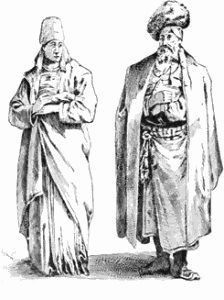History and Genetics: Sephardic Diaspora
Part VIII
Before discussing the Sephardic Diaspora, we need to note that the term “Sephardic” should be used technically to refer to Jews from the Iberian Peninsula and their descendents scattered toward the east as a result of the expulsions from Spain and Portugal. We need to distinguish Sephardic Jews from the Middle Eastern or Oriental Jews who were often been associated with them because of the latter’s use of the Sephardic prayerbook.
Jews were already established in the Iberian Peninsula in Roman times. Gradually they moved further north from the Mediterranean coastal region. By the Visigothic period (5th cent.-711 CE) evidence for a larger Jewish presence comes from the anti-Semitic decrees of the 6-7 centuries. Under Islamic rule, from 711, the Jewish community continued to grow, becoming an important part of Christian Spain, especially from 1085-1212 when the population rapidly expanded. With the rise of Christianity, the situation deteriorated. They were expelled from Spain in 1492 and from Portugal in 1497. While the Inquisition offer the opportunity for Jews to convert to Christianity, many elected to join a massive eastward migration that the place both on the northern and southern shores of the Mediterranean. It was… Continue reading
History and Genetics: Eastern Europe
After the expulsion of most of Ashkenazic Jewry from their homes in the 13th and fourteenth centuries,[1] many Jews drifted to Eastern Europe. Jewish settlement in Poland and Lithuania was for the most part in small communities although later Jews would cluster in larger towns and cities with the increasing modernization of the economy. Throughout the earlier period, however, and for many Jews even right up to the Holocaust, these smaller village communities (Shtetlach) remained the norm. This phenomenon has been used to explain the prevalence of certain diseases among East European Ashkenazic Jewry. It is assumed that rather small founding groups that for some reason had inherited these particular genetic characteristics originated these communities. The notion of a small number of founders certainly makes sense, since in general, the population of those expelled from Franco-Germany cannot have been large and they clearly established themselves in Eastern Europe in small communities. A number of genetic diseases found among Jews from Poland and Lithuania indicate later founding events for those communities, again in line with what our historical sources show. This community would have come into existence approximately 20 generations ago, which… Continue reading
Raphael Golb’s Plagiarism Harassment
Despite the attempts of Raphael Golb and his cohorts to paint me as a plagiarist, the NY Appellate Court has upheld his conviction. He was originally convicted of of identity theft in the second degree (2 counts), criminal impersonation in the second degree (14 counts), forgery in the third degree (10 counts), aggravated harassment in the second degree (3 counts), and unauthorized use of a computer. One of the 30 felony counts was thrown out but 29 were upheld.
Raphael Golb harassed a number of scholars on and offline, including myself, and eventually escalated this harassment to include impersonation of me in numerous emails. His false claims can still be found on blogs and webpages on Google, and in anticipation of the appeal, new articles have popped up online from supposedly respected publications, repeating the old accusations of plagiarism.
My colleagues and students and anyone in the know don’t give any credence to these claims and it is surprising that anyone would. A convicted felon is not usually the most reliable source of information. Now that Golb’s conviction has been upheld, it is to be hoped that the so-called “Lawrence Schiffman plagiarism case” will be put to bed.



